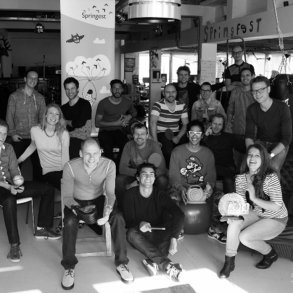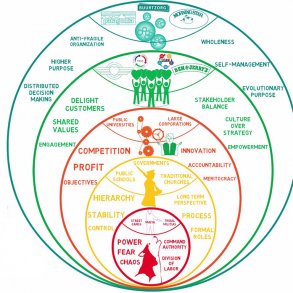By Joost Minnaar and originally published as a single article on corporate-rebels.com
This is Part 3 of a 4 part article. Part 1 is here. Part 2 is here.
3. Task Allocation
The process of task allocation in MMLOs seems defined by the nature of the work the teams need to do. Employees in the teams allocate tasks and roles based on voluntary, self-selected commitments and consensus decision-making. Employees emerge to fill natural leadership roles.
Customer-facing and support teams
The task allocation process in all three companies is influenced by the work team members must execute daily. A rough distinction can be made between two kind of teams; customer-facing teams (in direct contact with customers) and support teams that enable the customer-facing teams to deliver products and services in the best possible way.
At Buurtzorg, most teams are customer-facing and offer services to customers. They also have a small number of support teams at headquarters for tasks related to finance, legal and administration. Note that no group holds any formal authority over the others.
By way of contrast, most of Haier’s teams are support teams. Only a small number are in direct contact with end-users of their products. Most offer services for back-office functions like HR, legal and administration, or deliver services in designing, manufacturing and distributing Haier products. Any team at Haier can be dissolved or go bankrupt (most are separate legal entities) when they do not provide a competitive service or product – much like any start-up would in the marketplace.
Self-selected task commitments
In all three companies, employees allocate tasks and roles within their own teams. This is based on voluntary, self-selected task commitments and consensus decision-making. These commitments define decision-making roles in the team and assign accountability to the employees that take on those commitments.
At W.L. Gore, employees commit as individuals to the tasks and activities they wish to perform. These are called ‘self-commitments’, which means employees can join and leave teams based on their own needs and interests. However, once employees make commitments, they are expected not to break them, unless due to exceptional circumstances. And if an employee feels they are making a commitment that could threaten the organization’s survival, they are expected to review this with more experienced employees before they commence.
At Buurtzorg, all self-organizing teams must fulfil 7 roles. One of these is the main one (being a nurse) which must be shared by every member. All other roles (like administration, finance, collaboration, leadership and HR) must be distributed amongst team members. They do this in the way they think makes good use of the skills of all members. All major team decisions are by informal consensus. Team members collectively share responsibility for these commitments and decisions.
Likewise, at Haier, team members enjoy formal authority over their internal task allocation process. This means that teams define their own working relations and decide how to allocate task and roles within their teams. Teams make collective commitments to other teams in the form of contracts which often take place on their online platforms. Any contract can be renegotiated after a year.
Natural leadership roles
All three companies focus on natural leadership roles. That is, roles are often allocated to employees best positioned to do them. Again, there are roughly two kind of leadership roles: those within a team and those across several teams. Note that none of these roles include any responsibility for managing other employees, nor do they have any formal authority over others.
At W.L. Gore there are many leadership roles, with employees selecting leaders amongst peers based on credibility and their ability to attract followers. It is expected employees with the right expertise take on relevant decision-making responsibilities. This is internally referred to as ‘knowledge-based decision-making’. These leadership roles can take many different forms. For example, there are team leaders, business leaders and plant leaders. There is also a group of self-selected leaders referred to as sponsors. Sponsors offer feedback on performance, guidance in personal development, participation in the compensation process, and how to identify new ways of contributing.
A similar kind of leader can be found at Buurtzorg where all teams select their own informal leaders into ‘mentor’ roles. These mentors take care of things like onboarding and coaching. A small group is referred to as coaches. Each supports a group of teams with things like problem solving, network building, starting up new teams, and sharing best practice. These coaches are dedicated to a certain region and focus on facilitating solutions rather than providing them. This also means that leaders in Buurtzorg have no formal authority over other employees.
At Haier, teams formally select their own leaders who act as CEOs of microenterprises. These leaders are chosen by a consensus of team members. They can be replaced if the team is underperforming. These leaders act much like leaders of a start-up within a bigger company, and do not need any approval from top management for decision-making. There is also a group referred to as platform leaders. They support and promote collaboration between different teams on the same platform. However, once again, these leaders do not hold any formal authority over employees or teams.
Employees in large MMLOs allocate tasks and roles based on voluntary and self-selected commitments and consensus decision-making, often supported by natural leaders.
4. Coordination
Coordination of activities and tasks in large MMLOs happens mostly via direct person-to-person interaction and digital tools. Top management has established clear “rules of the game” to coordinate all activities and tasks as efficiently as possible.
Direct person-to-person interaction
In all three companies any employee can talk to anyone, an no-one tells another what to do. This means that all employees can interact freely with every other employee in the company with no intermediary (like a middle manager) necessary to coordinate this formally or informally. All three companies keep teams small on purpose, so team members can coordinate informally and in an efficient manner. It is for this reason that employees are expected to meet face-to-face regularly. Not surprisingly, perhaps, employees in natural leadership roles play an important part in the coordination process.
Since every employee at W.L. Gore needs to find and make their own task commitments, it is important to build an extensive personal network. Employees bear the responsibility to do this. This why most new employees at W.L. Gore spend their first few months building relationships and networks across the company, by working in several teams.
At Buurtzorg, team members meet at least one day every week in the office to coordinate work. The organization runs regular conferences and regional meetings to bring employees from different teams together, so they can get to know colleagues from other teams and learn from each other. In addition, teams at Buurtzorg are strongly embedded in the local community. Therefore, they coordinate their work locally with other stakeholders (like clients, doctors, families of clients).
Digital tools
All three companies have developed digital tools to facilitate coordination, especially for employees that are not physically close. This promotes high levels of connectivity throughout the company. This helps employees in sharing knowledge, experience and ideas. It also gives employees tools to coordinate and communicate with other stakeholders, like clients and suppliers. They exchange information in order to develop joint solutions to problems.
At Buurtzorg, a digital tool called BuurtzorgWeb aims to simplify the execution of day-to-day work activities, allowing employees to concentrate on face-to-face interaction with clients. It provides increased levels of transparency about all kinds of real-time information related to team-based and individual performance, client information, organizational strategy and financials. At W.L. Gore, for example, the top-management team shares financial results through digital tools with all employees, monthly.
At Haier, digital tools are used extensively to coordinate with customers and other partners. They use an online platform, called Haier Open Partnership Ecosystem, to communicate and collaborate with stakeholders. These are also used to get customer feedback on the design, development, production and use of their products. In this way Haier uses technology to engage with thousands of people in collaborative interactions and information-sharing in a cost-efficient manner.
Rules of the game
Although employees at all three companies have far reaching decision-making authority to coordinate work with others, they still need to observe organizational ‘rules of the game’. These are often established by the top-management team. All are expected to respect and enforce the rules of the game—to coordinate work efficiently, to resolve disputes fairly and to prevent new activities that would make the company less efficient. These rules of the game provide day to day guidance for teams to collaborate efficiently while trying not to compromise the independence of the teams.
At W.L. Gore, for example, there is a rule that restricts the size of any facility to a maximum of 300 employees. At Buurtzorg, there are rules that restrict teams from becoming larger than 12 employees. Plus, teams must meet an internal productivity target of 60%, meaning that 60% of their hours must be billable. Moreover, rental costs of accommodation cannot exceed 1% of team turnover, and 3% of an employee’s time must be devoted to training and education.
At Haier there is an extensive set of rules related to coordination between microenterprises. These cover internal contracting, performance standards and target setting. For example, all teams should set themselves ambitious growth and profitability targets, based on global market growth rates. These targets must be externally benchmarked and broken down to quarterly, monthly and even weekly goals for each individual and team.
Employees in large MMLOs coordinate work mostly through direct person-to-person interaction and digital tools. These coordination efforts are bounded by clear “rules of the game”.




